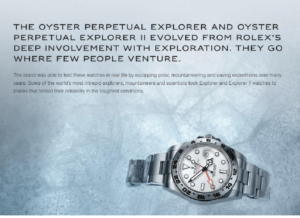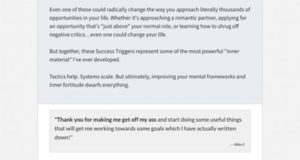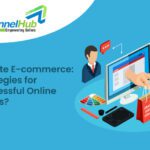5 Expert Tips to Optimize Your Ecommerce Copy For Conversions

What would a 20% increase in your conversion rate mean for your business? What about 50%, or a 100% increase?
These numbers are not unrealistic goals. With solid copywriting you can substantially increase your click through rates, opt in rates, and sales.
But how you use copywriting to do that is not so simple. You’ll have to apply techniques that go beyond the basics of copywriting. Once you have the basics covered, these 5 tips will make your copy even more effective.
Let’s dive in!
#1 Invest More Time in Your Headline
Our writing time is limited. So what should you spend it on? The answer is the part of your copy that has the biggest effect on your results – your headline.
The renowned copywriter David Oglivy said it best: “when you’ve written your headline, you’ve spent eighty cents out of your dollar.” According to Oglivy, on average 5 times as many people read the headline as read the body copy.
Your headline may be the large bold heading at the top of your page, your product title, or the first sentence of your copy. Either way it has to grip your reader and get their attention. Otherwise the rest of your copy will likely go unread.
That’s why it’s worth spending more time on your opening line to make sure it’s effective. Now that you know why headlines are so important, here’s some pointers on how to optimize your headlines to get your audience interested.
How to Hook Your Reader With Your Opening Line
The key is to address your reader’s deepest desire right in your opening line. That’s what gets them interested in reading more. It’s not enough to address the surface level desires your product fulfills.
You have to go past those surface level desires by asking why your reader wants those fulfilled. Keep following the trail of whys down until you get to the root desire that’s motivating them.
Rolex’s website has a great example of a headline that addresses their audience’s deepest desire.

The headline connects their product to their audience’s deepest desire. They don’t open with something like “get this good looking watch.” They don’t even open with a slightly deeper desire like “impress everyone else around you.”
Instead they speak to their readers’ deep desire to feel like an extraordinary person. Does that extraordinary person have a good looking watch and impress people? Yes, but these are more surface level desires.
The deeper desire Rolex is using for that product’s particular audience is the need to feel extraordinary, and be the kind of person that goes “where few people venture.”
By speaking to their readers’ deepest desire, Rolex grabs their ideal customer’s attention and gets them interested in reading more.
From there it’s up to the rest of the landing page to convince the reader that the product will fulfill that desire. That requires building trust, and testimonials are great for that.
#2 Use Testimonials in Your Descriptions to Make Them Feel Tangible
Few things build trust as quickly as testimonials. They’re powerful endorsements of your product from people just like your reader, or from people your reader emulates.
They’re so powerful that you shouldn’t hold your testimonials prisoner at the bottom of your page.
It’s standard practice to pile testimonials towards the bottom of your page. This isn’t a bad thing, but it isn’t the only place that testimonials can be used effectively. You can strategically place testimonials throughout your copy to make it even more persuasive.
Examples of real people’s experiences with your product makes your copy more tangible, which makes it more convincing. These examples can emphasize your reader’s pain points by showing someone dealing with the same problems, or they can show how your product actually changed someone’s life.
Those opportunities for building trust, while vividly showcasing the benefits of your product, are too good to miss. The copywriter and business owner Ramit Sethi knows this well. He’s a master at using testimonials throughout his landing pages.
Here’s an example of a testimonial he used in the landing page for one of his products.

In the blue text Ramit writes about the benefits of his product. He could’ve followed that up with more product features, which he includes further down the page. But before that he puts in a testimonial.
Instead of grouping all his testimonials together in one section, he pulls certain testimonials out to reinforce specific points.
Ramit is writing about taking more opportunities, so he includes a customer thanking him for helping them to get off their ass and take more opportunities. This adds credibility to what he’s saying, and makes his product’s benefits feel real.
It’s also important to note that the testimonial sounds natural and it’s specific. That’s what makes it work so well. It doesn’t just say: “Thanks to Success Triggers I’m happy. This thing is great.” Instead it describes exactly what the product helped the customer with, and the wording sounds authentic.
When choosing testimonials for your own copy make sure you choose good testimonials. Here’s a checklist to keep in mind when choosing what testimonials to highlight:
- Is it specific with detailed ways the product or service benefited the customer
- Does it sound authentic, like they’re written by a real person talking to a friend
- Ideally it should be written by someone your reader can relate to
Testimonials and copywriting in general are more effective when they’re specific as opposed to generic. Specificity and detail are also important to think about when you’re writing what’s known as a fascination.
#3 Entice Your Readers With “Fascinations”
What makes bullet lists so captivating? Maybe it’s the punchy rhythm, or maybe it’s their bold concise style. Whatever it is you’ll make your bullet lists doubly effective after learning about the little known copywriting term: fascinations.
What Are Fascinations?
Fascinations refer to a special kind of bulleted list. Each bullet in the list is designed to dangle a benefit before your readers eyes. But this isn’t just any useful benefit. It has to be absolutely fascinating. (hence the name)
The benefit should be astonishing, and the wording drastic enough, to arouse a combination of intense curiosity and desire.
Here’s a few examples, again from Ramit’s landing page for Success Triggers.

Who doesn’t want to learn the one simple hack for making your weeks twice as productive? It’s the wording that creates so much curiosity. The dramatic contrast between doubling our productivity and the ease of doing one simple hack, makes this benefit fascinating.
It goes beyond promising something simple. It doesn’t just say “make your weeks twice as productive.” Anyone could do that with enough effort. But few people could conceivably do it with one simple hack. It promises an astonishing benefit, and leaves us wondering what this hack could be.
How to Write Your Own Fascinations
The better your offer is, the easier writing fascinations will be. But even if a product isn’t extraordinary, you can still present it in a dramatic way.
Think about the most life changing benefits of your product. Maybe there’s a before and after transformation you can write about. Using numbers or statistics related to your product can also work well. If your product is 3 times faster, half the cost, or twice as effective, mention it!
Another good place to start is considering any surprising facts about your product. Were the metal materials mined in the remote wilderness of some exotic country? Is there a huge number of moving parts that make it work?
Even if these facts are common for most products in your industry, your readers probably won’t know. If you can connect these surprising facts to a benefit of your product, then you have the recipe for a great fascination.
A great list of fascinations will leave your prospects pining for your offer. But many will still have some questions that need to be addressed.
#4 Address Your Readers Burning Questions
No matter how convincing your copy is, some readers will still have questions. Those questions often arise from an objection, or a feeling that your product won’t work for them.
You must address these questions or you risk losing the sale. There could be any number of questions that come up. You need to find your customer’s most pressing concerns, and answer the burning questions they have about your product.
How to Find Your Readers Burning Questions
The best place to look for your customers most common questions is from your own customer support tickets.
What questions do people ask the most? What features of your product cause the most confusion? These are the questions that you should be addressing on your landing page – before people buy from you.
For every support ticket you receive with a question, there are more people with the same question who didn’t bother to email you.
For every question a customer emails you about, there are more people with the same question who won’t bother to email you. Instead they’ll just leave your website.
Take note of the questions that customers ask the most frequently, and the questions that might prevent people from buying.
If you haven’t started selling your product yet, Amazon is also great place to see what kinds of questions your customers might ask.
With products in every major niche, it’s likely you’ll find a product similar to yours. Plus Amazon and their sellers have already done the heavy lifting. You can easily find the most asked questions in the FAQ section on product pages.
Take note of both the questions in the FAQ section and the concerns that show up often in positive and negative reviews.

Once you have a list of your customers’ most burning questions, you’ll have to answer them in your copy. There are a few different methods to do this.
Answer Them With an FAQ Section and in Your Description
Having an FAQ section on your product page or landing page is a great way to clearly address your readers’ burning questions. Be sure to put the most commonly asked questions at the top of the list.
Another option is to address questions in your copy, whether that be in your first few sentences or in other sections of the page.
Pay attention to where questions might come up organically in your copy. Are you describing a feature that might be counterintuitive? Or is it not entirely clear how your product provides the benefit you’re mentioning? If the answer is yes, it’s probably worth mentioning in your copy.
Even if you have an FAQ section that addresses these questions, it’s a good idea to address them in your copy too if they come up. If your reader thinks of a question and they feel you haven’t addressed it, you’ll instantly lose credibility in their eyes. Some people gravitate more to reading your copy, while others might skim the page for an FAQ section.
Not everyone will interact with your landing page the same way. This is also something to consider when thinking about how your copy will be designed.
#5 Use Copy to Complement Your Design
If you’re like most marketers and business owners you’ll tend to think of copy and design as two separate things. It’s natural to think this way. Most businesses have separate processes for copy and design.
But the reality is your customers don’t see copy and design separately. They experience all the media on your ad, email, or website together.
When you know this you can use copy and design to play off each other. This can create a more unique and convincing experience than just using copy alone.
A Simple Way to Integrate Copy and Design Into One Powerful Message
There’s no limit to the creative ways copy and design can be used to complement each other. One of the simplest and most effective ways is to use copy that references or adds context to a striking image.
You can see this technique in action in a lot of ads where an image is prominent. Take a look at this BMW ad to see how they use copy to complement their design.

The copy directly references the image with the largest text “xDrive into the wild.” That call to adventure invites the reader into the scene depicted by the image. The copy makes it more than just an image of a car in rough terrain. Now it’s an invitation to drive there yourself.
The copy wouldn’t have the same message if the image of the landscape wasn’t there. In this example the copy and the image come together to create the message.
You don’t have to be a big budget ad agency to create a unique message with copy and images. Your copy can easily do more than just sit next to a pretty image.
Find the right story that will captivate your readers. Once you have that figured out you can align it with the unique visual aspects of your product, or the environment your product is used in. From there you can write copy to tie it all together into one cohesive message. One that will get your readers excited enough to reach into their wallets.
Conclusion
There’s no substitute for knowing your audience and writing clear benefit driven copy. But once you’ve done that, you can apply these tips to optimize your copy even further. When applied correctly they can even make the difference between a bounce and a conversion. Try them in your own copy and see.
Author Bio:
Will Solomon is a copywriter and eCommerce specialist. He’s used compelling copy to generate multiple six figures for himself and his clients. Learn more about Will at his website: wilsolomon.com
Write For Us
Gain multichannel inventory visibility and control with eChannelHub
Learn more about eChannelHub with a free demo, tailored for your unique retail business.
Request A DemoRequest a Demo
Gain multichannel inventory visibility and control with eChannelHub
Learn more about eChannelHub with a free demo, tailored for your unique online business




